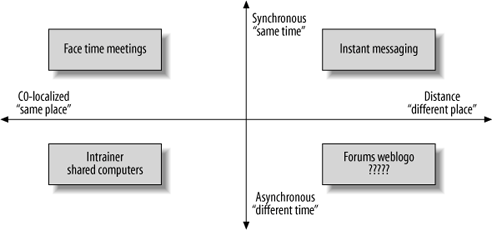| We define groupware as software that allows the people in an enterprise to participate in three broad classes of activity:
Communication Activities involving information and data sharing. Email, of course, is the primary medium of communication. In some instances, sharing information in a more structured manner, such as via discussion threads and by keeping archives and making them searchable, adds value to the information. Discussion forums (also called bulletin boards) are a popular and effective medium for this type of activity. Weblogs and Wiki Webs are emerging media that also address needs in distributed, non-real-time communications. Perhaps weblogs and Wikis are popular because they are lightweight, are easy to use, and have few access control restrictions. For more immediate and real-time communications, instant messaging solutions are appropriate. Use of instant messaging in the enterprise is a recent phenomenon, and best practices in this area are still unclear. Because of the disruptive nature of real-time communication, options such as instant messaging should be used sparingly.
Collaboration A process that seeks to build and develop a shared understanding that the collaborating parties did not have at the beginning of the process. Document sharing, Wikis, and discussion forums are popular ways of collaborating.
Coordination Coordination introduces order to collaboration activities. Workflows, task delegation, and notifications during shared document authoring are examples of coordination activities. Discussion forums, Wikis, and blogs offer notification features, by email or RSS, for example, that facilitate workflow building and other coordination efforts.
Groupware and collaboration technologies can be categorized along two primary dimensions, as shown in Figure D-1. Figure D-1. The dimensions of groupware and collaboration technologies 
It turns out that asynchronous distance collaboration methods, when aided by effective collaboration tools, also work well for groups that are collocated or are capable of synchronous collaboration but don't have the time for it. While it remains undisputed that face-to-face communication is the most effective means of collaboration and communication, it does come at a high cost. The groupware field has a large number of open source projects because of the distributed nature of the open source development process. Most open source projects use more than one form of asynchronous, distance-based collaboration tool. Some projects also use real-time, distance-based collaboration tools, such as Internet Relay Chat (IRC), to conduct "meetings" among developers and to provide support. |
